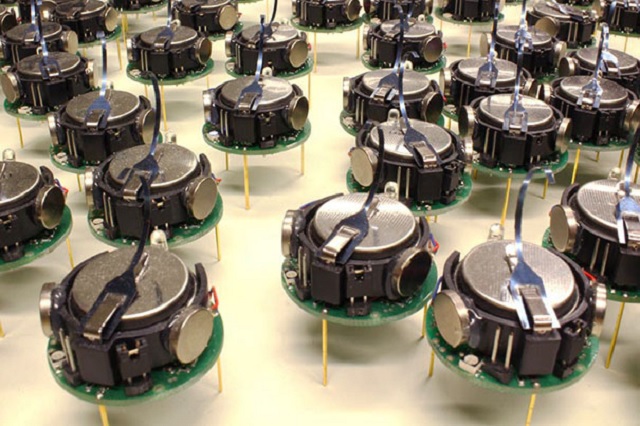 The Kilobots, a swarm of one thousand simple but collaborative robots. Photo courtesy of Mike Rubenstein and Science/AAAS.
The Kilobots, a swarm of one thousand simple but collaborative robots. Photo courtesy of Mike Rubenstein and Science/AAAS.
Researchers at the Harvard School of Engineering and Applied Sciences (SEAS) and the Wyss Institute have created autonomous robots that follow simple rules to gradually arrange themselves into complex, predetermined shapes.
This self-organising swarm, known as Kilobots, consists of 1,024 robots, which each measure just a few centimetres across. The Kilobots stand on three pin-like legs and work together to provide a simple platform to perform complex behaviours.
This phenomenon is similar in the way that thousands of individual cells arrange themselves to form an organism. This swarm of robots show how complexity can be achieved from simple behaviours when performed as a group and represent a major breakthrough in the advancement of collective artificial intelligence (AI).
Firstly, a command is sent to the Kilobots by a computer scientist using an infrared ligh. This command could be to form a shape such as the letter K. The robots then begin blinking at each other and organize themselves into a letter K shape. Once the origin of a coordinate system is marked by four robots, a 2D image is shown to the remaining robots, which they need to reproduce.
Programmable self-assembly in a thousand-robot swarm
The first thousand-robot flash mob has assembled at Harvard University. Courtesy of SEAS.
They then make of use of highly primitive methods, such as following the edge of a group and keeping track of the distance from the origin, in order to switch to their correct positions and complete the task.
An interesting feature of the Kilobots is that after an initial set of commands has been delivered, no further intervention is required.
The robots are also capable of fixing their own mistakes. If there is a traffic jam or any robot moves off-position, robots close by help each other and co-operate in order to fix these issues. The robots can communicate with their neighbours and sense their proximity using an infrared receiver and transmitter system.
The movement of each robot is carried out by two vibrating motors which allow it to slide on a particular surface. Although the robots themselves do have limitations, the smart algorithm overcomes these challenges and makes sure the robots can successfully complete the desired task.
The Kilobots could offer promising applications in the future in a variety of fields but for the time being, they serve as an important test bed for artificial intelligence algorithms. The study was published in the August issue of Science.